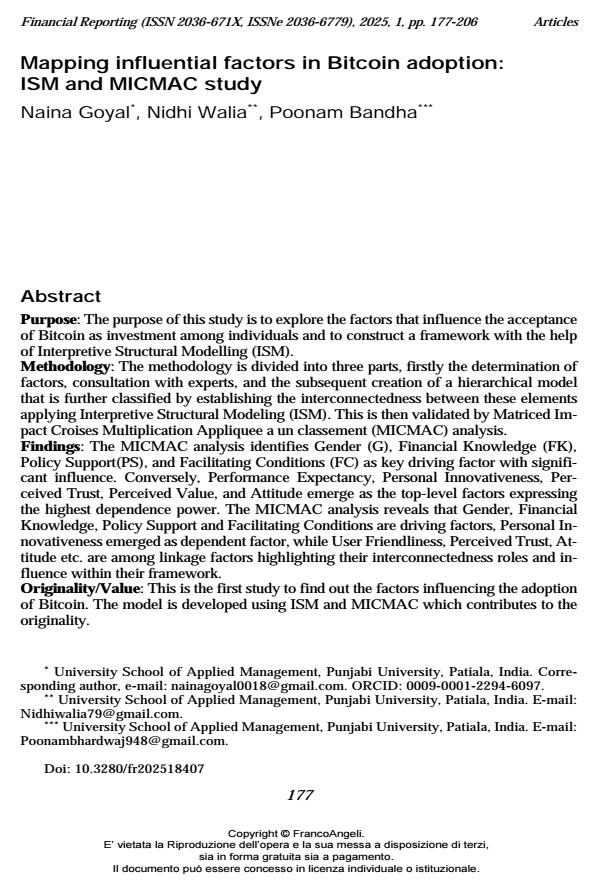Mapping influential factors in Bitcoin adoption: ISM and MICMAC study
Journal title FINANCIAL REPORTING
Author/s Naina Goyal, Nidhi Walia, Poonam Bandha
Publishing Year 2025 Issue 2025/1
Language English Pages 30 P. 177-206 File size 465 KB
DOI 10.3280/fr202518407
DOI is like a bar code for intellectual property: to have more infomation
click here
Below, you can see the article first page
If you want to buy this article in PDF format, you can do it, following the instructions to buy download credits

FrancoAngeli is member of Publishers International Linking Association, Inc (PILA), a not-for-profit association which run the CrossRef service enabling links to and from online scholarly content.
Purpose: The purpose of this study is to explore the factors that influence the acceptance of Bitcoin as investment among individuals and to construct a framework with the help of Interpretive Structural Modelling (ISM). Methodology: The methodology is divided into three parts, firstly the determination of factors, consultation with experts, and the subsequent creation of a hierarchical model that is further classified by establishing the interconnectedness between these elements applying Interpretive Structural Modeling (ISM). This is then validated by Matriced Impact Croises Multiplication Appliquee a un classement (MICMAC) analysis. Findings: The MICMAC analysis identifies Gender (G), Financial Knowledge (FK), Policy Support(PS), and Facilitating Conditions (FC) as key driving factor with significant influence. Conversely, Performance Expectancy, Personal Innovativeness, Perceived Trust, Perceived Value, and Attitude emerge as the top-level factors expressing the highest dependence power. The MICMAC analysis reveals that Gender, Financial Knowledge, Policy Support and Facilitating Conditions are driving factors, Personal Innovativeness emerged as dependent factor, while User Friendliness, Perceived Trust, Attitude etc. are among linkage factors highlighting their interconnectedness roles and influence within their framework. Originality/Value: This is the first study to find out the factors influencing the adoption of Bitcoin. The model is developed using ISM and MICMAC which contributes to the originality.
Keywords: distributed ledger technology, bitcoin, interpretive structural modeling, MICMAC analysis
Jel codes: G11
Naina Goyal, Nidhi Walia, Poonam Bandha, Mapping influential factors in Bitcoin adoption: ISM and MICMAC study in "FINANCIAL REPORTING" 1/2025, pp 177-206, DOI: 10.3280/fr202518407